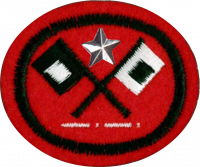Difference between revisions of "AY Honors/Communications - Advanced/Answer Key"
m |
|||
| Line 10: | Line 10: | ||
<noinclude><translate><!--T:11--> | <noinclude><translate><!--T:11--> | ||
</noinclude> | </noinclude> | ||
| − | {{: | + | {{:AY Honors/Code/Morse Code}} |
<!--T:12--> | <!--T:12--> | ||
| Line 18: | Line 18: | ||
<noinclude><translate><!--T:13--> | <noinclude><translate><!--T:13--> | ||
</noinclude> | </noinclude> | ||
| − | {{: | + | {{:AY Honors/Code/Semaphore Code}} |
<!--T:14--> | <!--T:14--> | ||
| Line 28: | Line 28: | ||
<!--T:5--> | <!--T:5--> | ||
| − | {{: | + | {{:AY Honors/Wigwag Code}} |
<!--T:6--> | <!--T:6--> | ||
Revision as of 03:57, 9 September 2021
Skill Level
3
Year
1956
Version
04.01.2025
Approval authority
General Conference
1
1a
1b
1c
Note that the US Army use of Wigwag does not use Morse Code but rather a single flag moved between positions 1, 2 and 3. Each letter is represented by a series of numbers.
The oldest flag system associated with the US Army Signal Corps is called Wig-wag. The name reflects the concept of back and forth movement as a means of signaling through motion. (PLEASE NOTE: Often this system has been misidentified as “Wig-wam.” A Wig-wam is a temporary arched framework structure overlaid with bark or hides to provide shelter used by Native Americans of the Algonquian language group.) Wig-wag is the signaling system developed for military field operations by Army surgeon Albert J. Myer prior to the Civil War. He developed this system based on a two element “tap-code” he created for the deaf. Myers’ Wig-wag system uses one flag for signaling. The position of the flags, left, right, front, represent the numerals 1, 2, 3 respectively and combinations of these numerals are used to convey the message. The one-flag Wig-wag system used a cotton flag of two, four, or six feet square. The larger the flag, the greater distance it could be seen. The flag pole could be extended to a length of 16 feet using 4-foot segments joined with brass fittings. It took a strong soldier to wave a 16 foot pole with a 6-foot square flag on it for an hour or more, especially in wind, heat and probably under enemy fire. During night operations, the flag was replaced with a specially designed kerosene fueled torch, but employed exactly as the flag would be during daytime. During daytime operations, different sizes and colors of flags were employed based upon atmospheric conditions, such as clouds, haze, blue sky, etc. The signal soldier had these varieties of flags as part of their kit, but at any one time, only one flag or torch was used for signaling.
The Myer Wig-wag system and associated codes were used by both Union and Confederate armies during the Civil War. The Union Navy also employed this system and it served as the first Joint Signal Code between the Army and Navy until the end of the nineteenth century.
For the code and photos see here.
References
- Wikipedia article on Morse Code
- Wikipedia article on Semaphores
- http://www.cromwellbutlers.com/sbb_0617.htm


